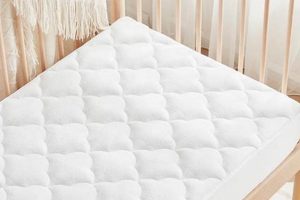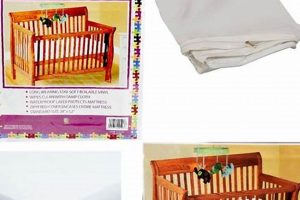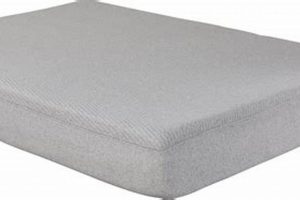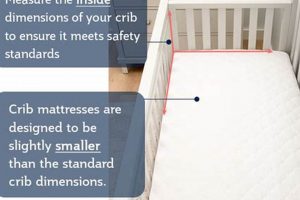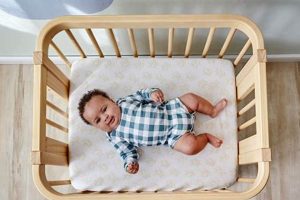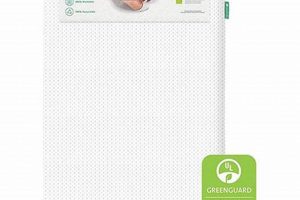The dimensions of a standard crib mattress are dictated by safety regulations. These mattresses typically measure approximately 28 inches wide by 52 inches long, with a thickness that generally does not exceed 6 inches. This standardized sizing ensures a snug and safe fit within a standard-sized crib frame.
Adherence to these regulated measurements is paramount for infant safety. A properly sized mattress eliminates gaps between the mattress and the crib frame, mitigating the risk of entrapment and potential suffocation. Historically, variations in crib and mattress sizes led to safety concerns, prompting the establishment of these standardized dimensions to safeguard infants.
The following sections will delve into the specific types of crib mattresses available, factors to consider when selecting a mattress, and guidelines for ensuring optimal safety and longevity.
Crib Mattress Size Considerations
The correct dimensions of a crib mattress are vital to infant safety and comfort. Consider these points when selecting and utilizing a crib mattress.
Tip 1: Verify Standard Dimensions: Confirm that the mattress adheres to the standard size of approximately 28 inches wide by 52 inches long. Measure the interior of the crib to ensure a tight fit.
Tip 2: Assess Mattress Thickness: The mattress thickness should not exceed 6 inches. Excessive thickness can reduce the height of the crib rails, potentially compromising safety.
Tip 3: Check for Gaps: Once the mattress is placed in the crib, inspect for gaps between the mattress edge and the crib frame. Gaps larger than two fingers’ width pose a safety hazard.
Tip 4: Evaluate Mattress Firmness: A firm mattress is crucial for infant safety. A soft mattress can conform to the infant’s face, increasing the risk of suffocation.
Tip 5: Consider Mattress Weight: While size is paramount, the weight of the mattress is a factor in ease of changing sheets and cleaning. Balance size needs with manageability.
Tip 6: Check Certifications: Look for certifications from reputable organizations that verify the mattress meets safety standards for chemical emissions and flammability.
Tip 7: Regularly Inspect Mattress Condition: Periodically examine the mattress for signs of wear, tear, or sagging. Replace the mattress if it no longer provides adequate support or fit.
Prioritizing these size and safety factors ensures a secure sleeping environment for the infant, reducing potential risks associated with an improperly sized or unsuitable mattress.
The following sections will delve deeper into specific types of crib mattresses, material considerations, and long-term care strategies for maintaining a safe sleep space.
1. Standard Dimensions
Standard dimensions are the cornerstone of crib mattress safety. These pre-defined measurements dictate the acceptable width, length, and thickness of a crib mattress, ensuring compatibility with standard-sized crib frames. Deviations from these dimensions can compromise the safety and functionality of the crib setup.
- Width Compliance
Width compliance refers to adherence to the standard width of approximately 28 inches. This dimension is crucial for preventing lateral gaps between the mattress and the crib sides, thus mitigating the risk of limb entrapment. Non-compliant mattresses may create dangerous spaces where an infant’s arm or leg could become lodged, leading to injury.
- Length Conformance
Length conformance mandates that the mattress adheres to the standard length of approximately 52 inches. A properly sized mattress ensures a snug fit along the length of the crib, preventing the infant from becoming trapped between the mattress and the crib ends. Mattresses that are too short or too long can introduce this hazard.
- Thickness Limitation
The thickness limitation typically restricts the mattress height to a maximum of 6 inches. Exceeding this thickness can reduce the height of the crib rails, making it easier for an infant to climb out of the crib and potentially fall. Thicker mattresses negate the protective function of the crib walls.
- Industry Certification
Standard dimensions are used by third-party certification organizations to ensure each mattress meets a minimum safety threshold. Certifications from organizations such as JPMA or Greenguard are an assurance that the mattress adheres to recommended dimensions and reduces overall safety risks.
These facets demonstrate the critical role of standard dimensions in guaranteeing a safe sleeping environment. Compliance with these established measurements is essential for minimizing the risk of entrapment, falls, and other potential hazards associated with an improperly sized crib mattress. The consistency provided by standard dimensions allows parents to make informed decisions and ensure the well-being of their infants.
2. Width Specification
Width specification is an integral component of crib mattress dimensions, directly influencing the safety and fit within a standard crib frame. Adherence to established width standards is paramount to preventing hazardous gaps and ensuring a secure sleeping environment for infants.
- Standard Width Requirement
The standard width requirement for a crib mattress is approximately 28 inches. This measurement is meticulously defined to ensure a snug fit within a standard crib, minimizing the risk of an infant becoming trapped between the mattress and the crib sides. Deviations from this specification can create dangerous gaps.
- Gap Prevention
The 28-inch width is specifically designed to prevent gaps exceeding two fingers’ width between the mattress and the crib frame. Gaps larger than this threshold pose a significant entrapment hazard, where an infant’s limbs or body could become lodged, leading to potential injury or suffocation. Maintaining the correct width specification is thus crucial for gap prevention.
- Crib Frame Compatibility
The width specification ensures compatibility with the internal dimensions of standard crib frames. Crib manufacturers design their products to accommodate mattresses adhering to this established width, ensuring a proper fit and preventing movement of the mattress during use. Incompatible widths can lead to instability and safety concerns.
- Testing and Compliance
Width specification is a key parameter in crib mattress testing and certification processes. Manufacturers must demonstrate that their mattresses meet the 28-inch standard to receive certifications from safety organizations. Compliance with this specification provides assurance that the mattress has undergone rigorous testing and meets established safety standards related to width dimensions.
In summary, the width specification is a non-negotiable aspect of crib mattress design and manufacturing. The established 28-inch width is essential for ensuring proper fit, preventing hazardous gaps, and promoting a secure sleeping environment for infants. Careful adherence to this specification is critical for minimizing the risk of entrapment and ensuring compatibility with standard crib frames, thereby contributing to overall infant safety.
3. Length Specification
The length specification is a critical dimension defining the overall size of a crib mattress. It dictates the longitudinal extent of the mattress, directly impacting its fit within a standard crib frame and subsequently, the safety of the infant.
- Standard Length Mandate
The established standard length for a crib mattress is approximately 52 inches. This mandated dimension ensures that the mattress fits snugly within a standard-sized crib, minimizing hazardous gaps at the head and foot of the crib. Deviation from this length can compromise the structural integrity of the sleep environment.
- End-Gap Mitigation
A primary function of the length specification is to mitigate gaps at the ends of the crib. When a mattress is shorter than the specified 52 inches, a potentially dangerous gap emerges, posing a risk of entrapment for the infant. Strict adherence to the length specification is essential for preventing such gaps and maintaining a safe sleep space.
- Crib Design Interdependence
Crib manufacturers design their products with the 52-inch length specification in mind. The internal dimensions of standard cribs are tailored to accommodate mattresses of this length, ensuring a secure and stable fit. Use of a non-standard length mattress can lead to instability and potential hazards due to incompatibility with the crib’s intended design.
- Safety Regulation Enforcement
Length specification is a key aspect of crib mattress safety regulations and certification processes. Regulatory bodies and certification organizations require manufacturers to demonstrate compliance with the 52-inch length standard. This enforcement ensures that crib mattresses available on the market meet minimum safety criteria and are designed to minimize the risk of infant injury.
In summary, the length specification is an indispensable element in defining the size of a crib mattress. By adhering to the established 52-inch standard, manufacturers ensure a secure and safe fit within standard crib frames, minimizing the risk of entrapment and promoting a stable sleep environment for infants. Compliance with this length specification is paramount for fulfilling the fundamental safety requirements associated with crib mattress design and manufacturing.
4. Thickness Maximum
The thickness maximum of a crib mattress is intrinsically linked to its overall size and, crucially, to infant safety within the crib environment. Regulating the maximum thickness, typically around 6 inches, directly influences the height of the crib rails relative to the mattress surface. If a mattress exceeds the recommended thickness, it effectively lowers the protective barrier of the crib sides, increasing the risk of a child climbing out and sustaining injuries from a fall. For example, a mattress that is 8 inches thick reduces the crib rail height by 2 inches, potentially creating a dangerous situation as the child grows and becomes more mobile.
The standardized maximum thickness is not arbitrary; it is determined by evaluating the ergonomic needs of developing infants and toddlers in conjunction with established crib design parameters. Thicker mattresses, while potentially offering more cushioning, compromise the safety envelope designed into the crib. Furthermore, maintaining the prescribed thickness allows for the consistent application of safety standards across different crib and mattress manufacturers. This consistency ensures that parents can reasonably expect a uniform level of protection, irrespective of brand choice. Safety testing protocols include assessments that would flag non-compliant mattresses exceeding the specified thickness, serving as an additional safeguard for consumers.
In summary, the thickness maximum is an essential and regulated dimension of a crib mattress. It’s not merely an aesthetic consideration but a crucial safety feature. By adhering to the maximum thickness, the intended safety features of a standard crib are preserved, mitigating the risk of falls. Consequently, the thickness maximum constitutes a vital component of what defines a safe and appropriately sized crib mattress, playing a pivotal role in infant injury prevention.
5. Internal Fit
Internal fit, in the context of “what is the size of a crib mattress,” refers to the precise correspondence between the exterior dimensions of the mattress and the interior dimensions of the crib frame. A proper internal fit is not merely a matter of convenience; it’s a foundational element of crib safety. When a mattress does not fit snugly within the crib, gaps arise, presenting a significant risk of infant entrapment. The regulated dimensions of crib mattresses are established to ensure a nearly gap-free fit, thereby minimizing the chance of an infant’s limbs or body becoming lodged between the mattress and the crib sides. This principle is underscored by documented instances where improperly fitted mattresses contributed to infant injuries and, in tragic cases, fatalities. For instance, a mattress that is even slightly too small for a crib can create a space where a baby’s head can become trapped, leading to suffocation. The internal fit, therefore, is a direct determinant of the safety and functionality of the crib system.
Understanding the practical implications of internal fit is essential for caregivers. Before placing an infant in a crib, the fit of the mattress should be meticulously assessed. The measurement process must account for the manufacturer’s stated dimensions of both the crib and the mattress. A simple, yet crucial, verification step involves pushing the mattress firmly against each side of the crib in turn to check for unacceptable gaps. The common guideline is that any gap exceeding the width of two fingers should be considered unsafe. If such gaps exist, the mattress is deemed incompatible and should not be used. Moreover, caregivers should be aware that even a mattress that initially seems to fit properly can shift over time due to wear and tear or compression, requiring periodic reassessment of the internal fit.
The challenge of achieving a perfect internal fit underscores the importance of adhering to industry standards and regulatory guidelines for crib and mattress dimensions. While manufacturers strive to meet these standards, slight variations can occur, highlighting the necessity for careful inspection. Ultimately, the critical insight is that “what is the size of a crib mattress” is not just a specification on a product label, but a safety imperative that demands vigilant attention to ensure a secure sleep environment for the infant. The precise internal fit of the mattress within the crib is the last line of defense against a serious safety hazard.
6. Gap Tolerance
Gap tolerance, in the context of “what is the size of a crib mattress,” defines the permissible space between the mattress edge and the interior frame of the crib. This tolerance is not arbitrary; it represents a critical safety threshold designed to prevent infant entrapment and suffocation. The size of a crib mattress is therefore inextricably linked to gap tolerance, as even minor deviations from standard dimensions can exponentially increase the risk of hazardous gaps. For instance, a mattress that is half an inch too narrow, when combined with manufacturing variations in the crib frame, can easily exceed the maximum safe gap tolerance. Failure to maintain a strict gap tolerance effectively nullifies the safety measures incorporated into the crib’s design, transforming a protective environment into a potential hazard.
The practical significance of understanding gap tolerance extends beyond simply verifying the “size of a crib mattress.” It necessitates a proactive approach to crib safety that includes regular inspections. Caregivers should routinely check for excessive gaps around the mattress perimeter, using the established guideline of no more than two fingers’ width. This routine vigilance is particularly important as mattresses can compress or shift over time, widening existing gaps. Furthermore, caregivers must be aware that the type of crib whether it is a standard, mini, or convertible model impacts the acceptable size of the mattress and consequently, the corresponding gap tolerance. Employing mattresses intended for different crib types can result in significant dimensional mismatches, creating gaps that pose serious risks.
In conclusion, gap tolerance is an indispensable component of “what is the size of a crib mattress,” serving as a direct measure of crib safety. It’s not enough to simply purchase a mattress labeled as “standard size”; meticulous attention must be paid to the actual fit within the crib frame. The consequences of exceeding acceptable gap tolerances can be severe, underscoring the need for stringent adherence to size standards and consistent monitoring of the mattress-crib interface. Addressing potential challenges proactively and promoting awareness of this critical link will help safeguard infants and ensure their well-being in their sleeping environment.
Frequently Asked Questions
The following questions address common concerns regarding the dimensions of crib mattresses and their implications for infant safety.
Question 1: What are the standard dimensions for a full-size crib mattress?
A standard full-size crib mattress measures approximately 28 inches wide and 52 inches long. This standardized sizing is crucial for ensuring a safe and snug fit within a standard crib frame.
Question 2: Why is it important to adhere to the standard crib mattress size?
Adhering to standard dimensions is critical to prevent hazardous gaps between the mattress and the crib frame. These gaps can pose a significant risk of infant entrapment or suffocation.
Question 3: What is the maximum acceptable thickness for a crib mattress?
The maximum acceptable thickness for a crib mattress is generally 6 inches. Exceeding this thickness can reduce the height of the crib rails, increasing the risk of a child climbing out.
Question 4: How should a crib mattress fit within the crib frame?
A crib mattress should fit snugly within the crib frame, leaving no gaps larger than two fingers’ width. A tight fit is essential to prevent entrapment and ensure a safe sleeping environment.
Question 5: Are there different sizes of crib mattresses?
While standard-size crib mattresses are the most common, mini-crib mattresses are also available for smaller cribs or compact spaces. Verify the crib’s specifications to ensure the correct mattress size is selected.
Question 6: Where can the dimensions of a crib mattress typically be found?
The dimensions of a crib mattress are typically listed on the product label, packaging, or manufacturer’s website. Always verify the dimensions before purchasing to ensure compatibility with the intended crib.
Understanding the appropriate dimensions of a crib mattress is fundamental to ensuring a safe sleep environment for infants. Prioritizing these size considerations reduces potential hazards and promotes a more secure crib setup.
The next section will examine the various types of materials used in crib mattress construction and their safety implications.
Crib Mattress Dimensions
This exploration of crib mattress dimensions underscores the paramount importance of adhering to standardized measurements. The prescribed width, length, and thickness are not arbitrary figures; they represent a carefully calibrated framework designed to mitigate the risk of infant injury and potential fatality. Maintaining precise dimensions minimizes the likelihood of hazardous gaps, ensures proper crib rail height, and promotes a secure sleep environment.
Given the irrefutable link between crib mattress dimensions and infant safety, diligent verification of size specifications and meticulous assessment of mattress fit are non-negotiable responsibilities. Continued adherence to industry standards, coupled with ongoing vigilance in monitoring mattress condition, will remain essential for safeguarding the well-being of vulnerable infants within their cribs. The dimensions of a crib mattress represent more than mere measurements; they symbolize a commitment to protecting the most vulnerable members of society.


